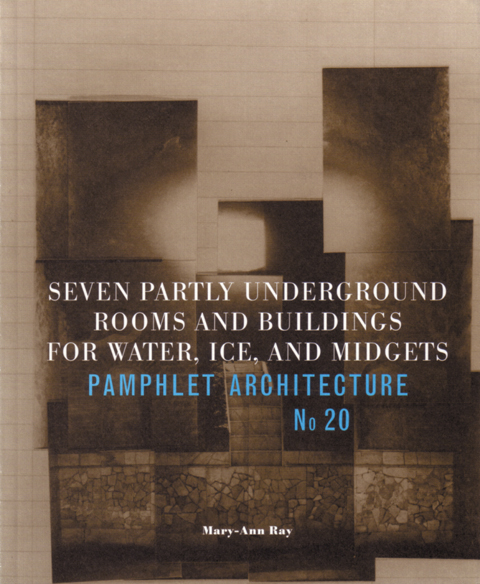 Seven Party Underground Rooms and Buildings for Water, Ice, and Midgets (1997)
Seven Party Underground Rooms and Buildings for Water, Ice, and Midgets (1997)
by Mary-Ann Ray
(I first heard of Pamphlet Architecture, and Mary-Ann Ray’s work in particular, at the first BLDG Blog event.)
I found this book/magazine interesting and informative, but ultimately unsatisfactory. The writing style is clever and straightforward at the same time, and I appreciate that very much; however, no matter how straightforward, these buildings are impossible to describe adequately with words.
Moreover, Mary-Ann’s photo composite technique (see “Notes on Photography” below and in book) ultimately doesn’t do what it purports to do (at least for me). It is a way to show multiple sides/views of something, like showing the well as “every window” photographed from “every window” across from it. And I appreciate it conceptually, but the images don’t draw the viewer into an understanding of the space and its layout.
To me the complexities of collaging these photos together simply point out and even exaggerate the inadequacies of photography in conveying a feeling of these complex spaces. The inadequacies of photography, combined with the inadequacies of words, may actually accomplish what Mary-Ann probably set out to do–make people want to see these spaces for themselves–but the combination leads to an, as I said, unsatisfactory reading and resource.
However, the reading is still in many ways worthwhile. Here is a selection of historical and architectural ideas and observances gleaned from Mary-Ann Ray’s work:
I. Pozzo di San Patrizio (Well of St. Patrick)
Photos: “Every Window from One Window” “Every Window from Every Window”
“The inner cylinder encloses the light well shaft and is continuous and unbroken for almost 60 meters. The outer cylinder holds two superimposed, independent, and non-communicating stepped helical ramps…The ramps are entered from above ground by separate doors, one facing north, the other south. The paths of the two ramps cross only at one point, at the bridge crossing the bottom of the well.”
II. Tumulo della Cornice (Tomb of the Cornice)
“The legends of the local tombarolli (grave robbers) support the notion that the tombs remained airless and airtight until opened…. Today, with the door open to the elements, light and water enter this space below grade. With the floor of the central room covered with water and the angle of the sun coinciding with the angle of the furrowed cut, an image of anything between the sun and the water surface is cast through the bellows of the stone side walls and thrown upside down by reflection from the surface of water onto the frame of the far wall. One the facade of that wall ahead, the visitor is faced with an upside-down image of their own body, backed by moving images of upside-down clouds. It is literally a camera obscura, an enactment of Plato’s cave, the primal cinema.”
III. Sette Sale (Seven Halls)–water distribution and filtration
Photos: “Perpendicular to Parallel Walls” “Parallel to Parallel Walls”
“The disposition of the ten parallel walls that define the nine parallel halls, and the disposition of the door openings along a diagonal pattern, comprise a repetitive and rational composition…which is experienced more as a disorienting labyrinth than an ordered plan. This building without place is a network or web of paths, paths that are parallel to parallel walls, perpendicular to parallel walls, and diagonal through parallel walls.”
IV. Triclinium, Praedia di Giulia Felix (Properties of Giulia Felix)
“Some revolutionary Romans, who preferred intelligent conversation to decadent entertainment, offered the word convivium to replace the ancient Greek word then in use for these dinner parties, symposium, which translates as ‘drinking together.'”
V. L’Appartamento dei Nani (Midget Chambers)
“these rooms have been associated with the dwarves kept by the Gonzaga courts for amusement and companionship”
“The surfaces of these chambers are coated with flesh-hued stucco relief. Unlike the piano nobile rooms which are finely painted, illusionistic surfaces in color, these rooms are clad with deeply dimensional patterns that are chiaroscuroed in the raking oil lamp illumination.”
VI. Tepidarium, Terme Suburbane (Tepid Pool, Suburban Baths)
“Circulation in the terpidarium refers less to the movement of bodies through space than to the flow of fluids and hot gasses within the cavities and channels inside the walls and floors.”
VII. Ghiacciaia, Villa Ranuzzi-Cospi (Icehouse, Villa Ranuzzi-Cospi)
“The spherical form of the icehouse…also builds in a geometrical structural advantage….The upper half resists gravity pulling down and out on it, while the bottom half fights back against the surrounding soil that pushes up and in on it. This triaxially symmetrical structure is half-pushed and half-pulled.”
Afterword: Notes on the Technique and Method of Photography
“The ‘composite’ or ‘built frame’ photograph is a format borrowed from the work of Sherie Scheer, David Hockney, Jan Dibbetts, and others. The format allows a ‘regular’ camera to perform like a ‘hyper-camera…”
supposed benefits of the resulting image:
- trace space
- edit and include specificity
- depict multiple views
- show various sides of something and movement
- change the relationship between the subject and the viewer
